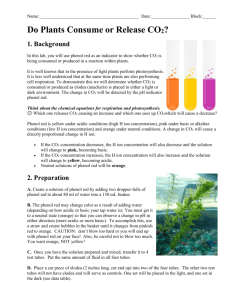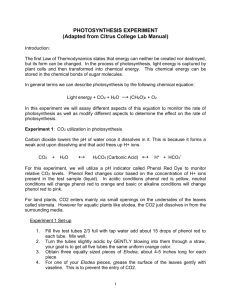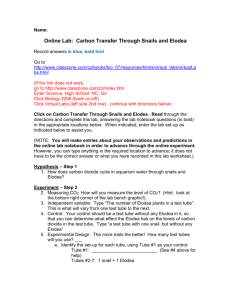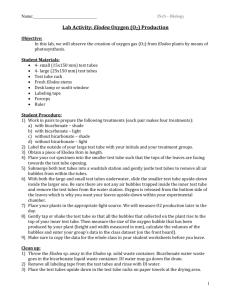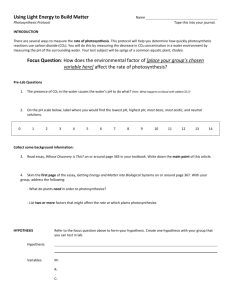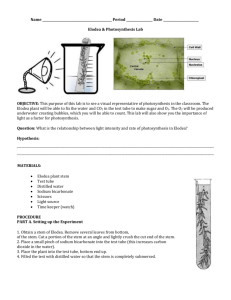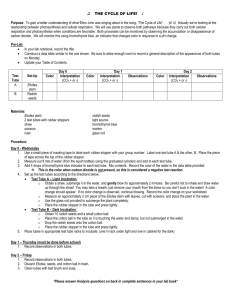Biology Terrestrial Sequestration
advertisement
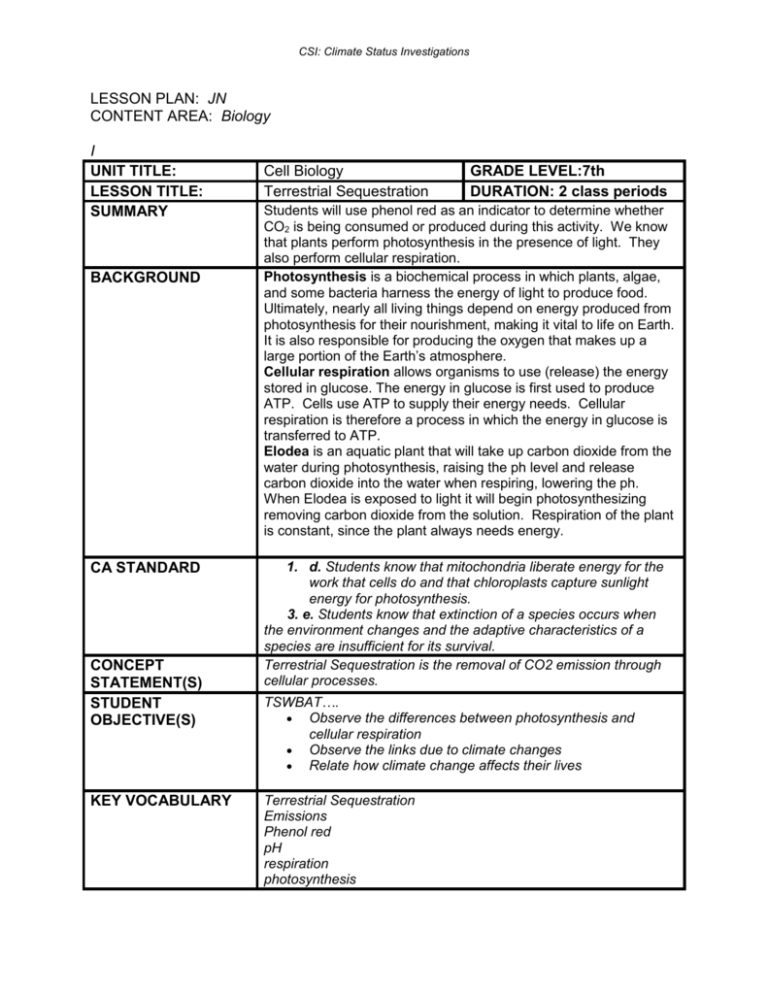
CSI: Climate Status Investigations LESSON PLAN: JN CONTENT AREA: Biology I UNIT TITLE: LESSON TITLE: SUMMARY BACKGROUND CA STANDARD CONCEPT STATEMENT(S) STUDENT OBJECTIVE(S) KEY VOCABULARY Cell Biology Terrestrial Sequestration GRADE LEVEL:7th DURATION: 2 class periods Students will use phenol red as an indicator to determine whether CO2 is being consumed or produced during this activity. We know that plants perform photosynthesis in the presence of light. They also perform cellular respiration. Photosynthesis is a biochemical process in which plants, algae, and some bacteria harness the energy of light to produce food. Ultimately, nearly all living things depend on energy produced from photosynthesis for their nourishment, making it vital to life on Earth. It is also responsible for producing the oxygen that makes up a large portion of the Earth’s atmosphere. Cellular respiration allows organisms to use (release) the energy stored in glucose. The energy in glucose is first used to produce ATP. Cells use ATP to supply their energy needs. Cellular respiration is therefore a process in which the energy in glucose is transferred to ATP. Elodea is an aquatic plant that will take up carbon dioxide from the water during photosynthesis, raising the ph level and release carbon dioxide into the water when respiring, lowering the ph. When Elodea is exposed to light it will begin photosynthesizing removing carbon dioxide from the solution. Respiration of the plant is constant, since the plant always needs energy. 1. d. Students know that mitochondria liberate energy for the work that cells do and that chloroplasts capture sunlight energy for photosynthesis. 3. e. Students know that extinction of a species occurs when the environment changes and the adaptive characteristics of a species are insufficient for its survival. Terrestrial Sequestration is the removal of CO2 emission through cellular processes. TSWBAT…. Observe the differences between photosynthesis and cellular respiration Observe the links due to climate changes Relate how climate change affects their lives Terrestrial Sequestration Emissions Phenol red pH respiration photosynthesis CSI: Climate Status Investigations FORMATIVE ASSESSMENT SUMMATIVE ASSESSMENT TECHNOLOGY THREAD acidic basic elodea Have a free write at the beginning of class on what the students think sustainability is and from what they learned about photosynthesis, would plants be able to help the climate change. Develop one or two questions that might be included in the summative assessment or Unit Test related to this lesson Will need a computer and hook up to projector – will go through interactive video as a class to look at the different methods of sequestration http://www.pbs.org/wgbh/nova/tech/carbon-sink.html TEACHER PREPARATION MATERIALS ADVANCE PREPARATION SAFETY CONSIDERATI ONS ACCOMMODAT IONS (ELL, GATE, Special Needs) 6 test tubes 2 test tube racks 6 rubber stoppers 1 250ml beaker 150ml of phenol red plant leaves (aquatic plant – Elodea) CO2 generator (250 mL flask with rubber stopper and tubing) baking soda vinegar lamp microspoon spatula 30 copies of Terrestrial Sequestration – Student Sheet Make phenol red concentration Buy Elodea When the students put together the CO2 generator. Go over glass safety and stoppers LESSON IMPLEMENTATION Lesson Component Gain Attention Teacher Does Anticipatory Set: I am not sure how to start this one. Maybe have a picture of a glacier back from 1950’s compared to one now on the overhead. Student Does What will be the student expected reaction/response? CSI: Climate Status Investigations Main Presentation Elicit Student Performance I don’t want to scare my students though. Day 1 Have students pair-share their free writes Open up to a class discussion Go through interactive video Ask for questions Go over lab write and procedure Day 2 Start class with quick review Have students begin lab Start Lab. Have students work in groups of 4 to work through elodea lab. During the lab, there will be a lot of down time so I will need to have a supplemental assignment for the students to work on while watching for color change. Provide Feedback Use the cup method again for on Performance lab – green, yellow and red to Note the student expected responses to questions you may ask in your presentation. This is also a good section to annotate AFTER you have taught the lesson – it will be easier to judge responses after you have taught the lesson more thn once. What will the students be doing? Checking answers, reinforcing correct procedures check for understanding Closure Assessment/Eval uation APPLICATION/EXT ENSIONS REFERENCES Go over the changes that happened in each test tube. Have a group discussion on the importance of plants/forests for carbon sequestration. Look at other options for carbon sequestration – ocean. Students’ lab write up, mainly the conclusion. Use interactive notebook to check for understanding . Ask students how they would be able to change their CO2 emissions, In what ways would they be able to come up with a solution for lowering CO2 emissions personally to internationally. http://keystone.org/files/file/KeyCurriculum/MiddleSchoolFiles/S_Te rrestrialSequestration.pdf attached below CSI: Climate Status Investigations CROSSCURRICULAR CONNECTIONS What connections can you make to another discipline/content area? For example: “The data collected here in this science verification lab can be used in math for analysis of trends, line/curve of best fit, regression analysis, etc.“ Remember that when your students learn something that can be used or related to another discipline it is a win-win situation for both sides. CSI: Climate Status Investigations Terrestrial Sequestration – Photosynthesis and Cellular Respiration Science Goal: Students define key terms and link plant cellular functions based on experimental data and observations. Objectives: Students will … Observe the differences between photosynthesis and cellular respiration Observe the links due to climate changes Relate how climate change affects their lives Materials (for each group): 6 test tubes 2 test tube racks 6 rubber stoppers 1 250ml beaker 150ml of phenol red plant leaves (aquatic plant – Elodea) CO2 generator (250 mL flask with rubber stopper and tubing) baking soda vinegar lamp microspoon spatula 30 copies of Terrestrial Sequestration – Student Sheet Time Required: 45-60 minute class period Standards Met: S1, S2, S3, S4 Procedure: PREP Set up lab stations, enough to have no more than 4 students per group. Review background information. Make phenol red. Purchase Elodea (available online or at local pet stores). IN CLASS Explain to students that they will be investigating the carbon cycle as it relates to global climate change. Get students into groups of 3 or 4. Hand out Terrestrial Sequestration – Student Sheets. Review the background information. Review the student procedure and expectations. Circulate as students begin the lab. Students should continue to monitor the experiment, record data in the chart and answer the questions. When comparing the color in the test tube, place in front of a white background. CSI: Climate Status Investigations Assessment: Participation in the activity Completed Terrestrial Sequestration – Student Sheet Terrestrial Sequestration – Photosynthesis and Cellular Respiration Teacher Background Information Photosynthesis is a biochemical process in which plants, algae, and some bacteria harness the energy of light to produce food. Ultimately, nearly all living things depend on energy produced from photosynthesis for their nourishment, making it vital to life on Earth. It is also responsible for producing the oxygen that makes up a large portion of the Earth’s atmosphere. Cellular respiration allows organisms to use (release) the energy stored in glucose. The energy in glucose is first used to produce ATP. Cells use ATP to supply their energy needs. Cellular respiration is therefore a process in which the energy in glucose is transferred to ATP. This Lab will use phenol red as an indicator to determine whether CO2 is being consumed or produced during this activity. We know that plants perform photosynthesis in the presence of light. They also perform cellular respiration. To demonstrate this we will observe what happens in a light and dark environment as we add Elodea to a test tube of acidic phenol red. We will observe any changes in CO2 by using the ph indicator phenol red. Phenol red is a yellow color at a pH 6.4 or lower and a red color at a pH of 8.2 or above. Elodea is an aquatic plant that will take up carbon dioxide from the water during photosynthesis, raising the ph level and release carbon dioxide into the water when respiring, lowering the ph. When Elodea is exposed to light it will begin photosynthesizing removing carbon dioxide from the solution. Respiration of the plant is constant, since the plant always needs energy. One problem you’ll encounter when studying respiration in plants is that in the presence of sunlight they begin photosynthesis and this counteracts respiration. One way to measure respiration is by placing the Elodea in the dark. CSI: Climate Status Investigations Terrestrial Sequestration– Student Sheet Follow the steps below to successfully complete the lab. Procedure: Place 3 test tubes in each test tube rack. Fill the third test tube in each test tube rack ¾ full from the 150ml of phenol red (this will be the constant), and put a rubber stopper on both test tubes. Make a CO2 generator by filling the bottom of the 250ml flask with baking soda. Place the two-hole rubber stopper (containing the plastic tubes and rubber tubing) on the flask and slowing inject vinegar into the baking soda through the plastic tubing using a syringe. The long rubber tubing is placed in the beaker containing the remaining phenol red. CO2 will bubble through the solution turning the phenol red acidic. The color changes to orangeyellow. (The more acidic the phenol red, the longer it will take the Elodea plant to absorb the CO2). Submerge a sprig of Elodea completely into the first test tube in both test tube racks. Fill the remaining 4 test tubes (including the ones with the Elodea) ¾ full with the acidic phenol red solution that you just made using the CO2 generator. Cover each test tube with a rubber stopper. Each test tube rack should have 3 test tubes. The first test tube should contain the Elodea in the acidic phenol red, the second contains just acidic phenol red, and the third is phenol red (the constant). Place one test tube rack (containing the 3 test tubes) under the light source. Place the other test tube rack (containing the 3 test tubes) in the dark. All test tubes should be sealed with rubber stoppers, aluminum foil, or parafilm to reduce the reactions with the air. In approximately 60 minutes, you’ll notice a color change. Record the data on the chart and answer the question. Hypothesis: What do you think will happen when you place the aquatic plant, Elodea in acidic phenol red in a light and dark environment for a period of 60 minutes? ________________________________________________________________________________________ ____________________________________________________________________ Complete the Table Phenol red with Elodea In the Dark Observations (color change) CSI: Climate Status Investigations In the Light What did this experiment tell us about the role of plants in our environment? WORKSHOP COPY Terrestrial Sequestration – Photosynthesis and Cellular Respiration Student Sheet Follow the steps below to successfully complete the lab. Procedure: Place 3 test tubes in each test tube rack. Fill the third test tube in each test tube rack ¾ full from the 150ml of phenol red (this will be the constant), and put a rubber stopper on both test tubes. Make a CO2 generator by filling the bottom of the 250ml flask with baking soda. Place the two-hole rubber stopper (containing the plastic tubes and rubber tubing) on the flask and slowing inject vinegar into the baking soda through the plastic tubing using a syringe. The long rubber tubing is placed in the beaker containing the remaining phenol red. CO2 will bubble through the solution turning the phenol red acidic. The color changes to orangeyellow. (The more acidic the phenol red, the longer it will take the Elodea plant to absorb the CO2). Submerge a sprig of Elodea completely into the first test tube in both test tube racks. Fill the remaining 4 test tubes (including the ones with the Elodea) ¾ full with the acidic phenol red solution that you just made using the CO2 generator. Cover each test tube with a rubber stopper. Each test tube rack should have 3 test tubes. The first test tube should contain the Elodea in the acidic phenol red, the second contains just acidic phenol red, and the third is phenol red (the constant). Place one test tube rack (containing the 3 test tubes) under the light source. Place the other test tube rack (containing the 3 test tubes) in the dark. All test tubes should be sealed with rubber stoppers, aluminum foil, or parafilm to reduce the reactions with the air. CSI: Climate Status Investigations In approximately 60 minutes, you’ll notice a color change. Record the data on the chart and answer the question. WORKSHOP COPY Hypothesis: What do you think will happen when you place the aquatic plant, Elodea in acidic phenol red in a light and dark environment for a period of 60 minutes? ________________________________________________________________________________________ ____________________________________________________________________ Complete the Table Phenol red with Elodea In the Dark Observations (color change) In the Light What did this experiment tell us about the role of plants in our environment?
